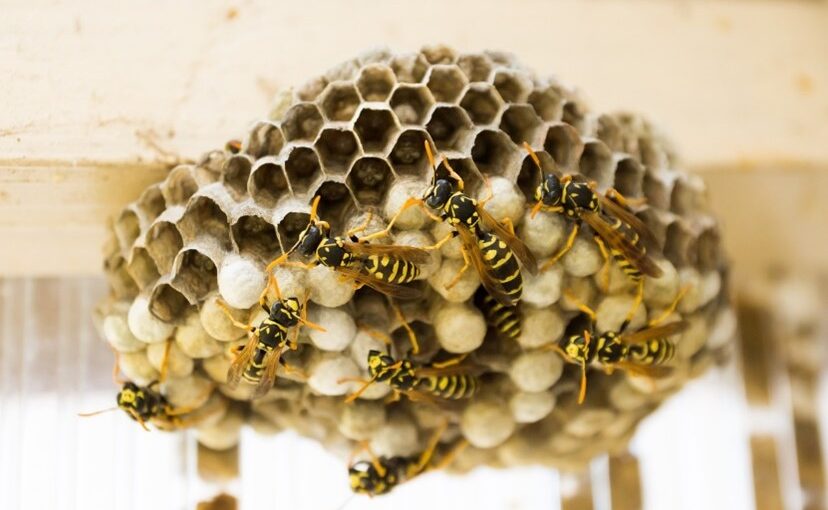
Wasps and bees, particularly the yellowjacket wasps, can be a significant nuisance in Colorado, especially later in the summer when they gather at outdoor food areas. Despite their bothersome presence, these insects are generally beneficial for their roles as pest predators and pollinators. Social wasp colonies start in spring with a single fertilized female and grow through the summer. By season’s end, colonies can host hundreds of individuals, including potential new queens.
Western Yellowjackets
Social wasps build nests from chewed wood and paper. These nests are small early in the season but expand as more wasps are raised. Unlike other social wasps, the western yellowjacket primarily scavenges dead insects, earthworms, and other carrion, including garbage, making their scavenging habit a serious nuisance. Yellowjackets, mistaken for honey bees due to their coloring but not as hairy, usually nest underground and can become aggressive if their nests are disturbed. Sometimes, their nests may be located in dark, enclosed parts of a building, like crawl spaces or wall voids.
Baldfaced Hornets
In contrast, hornets build large, visible grayish paper nests in trees, shrubs, and under building eaves. Hornets feed their young live insects, such as caterpillars, and do not share the scavenging habit of yellowjackets. The most common species in Colorado is the baldfaced hornet. Their nests often attract attention because of their large size, but hornets rarely sting unless the colony is seriously disturbed.
European Paper Wasps
Paper wasps, known for their open-cell paper nests, are commonly found under building overhangs. The European paper wasp, a newer species in Colorado, tends to nest in small cavities on building sides, inside metal gutters and poles, outdoor grills, and similar areas. These wasps have a more slender body compared to other social wasps. Typically, native paper wasps sport a reddish-brown and yellow coloration, while the European paper wasp features shiny black and yellow markings, making it easy to confuse with a yellowjacket.
Paper wasps are valuable as they prey on caterpillars and other insects without scavenging. Nevertheless, the European paper wasp’s tendency to nest in various yard locations has significantly increased the frequency of stings from this group of wasps.
Controlling Social Wasps
Control of these wasps is best handled by waiting until the nests are abandoned in the fall. However, an insecticide may be necessary for immediate issues, especially when nests are large and problematic. It is estimated that the western yellowjacket is responsible for at least 90 percent of the bee stings in Colorado.
Many concerns with social wasps occur late in the season when colonies grow large, and the above-ground nests of hornets and paper wasps become apparent. If the wasps are not causing a problem, the best solution is to wait until the nest is abandoned in the fall. The nest can be safely removed in the winter or, if left alone, will break up during late fall and winter. For active nests that are causing problems, contact Front Range Pest for safe and effective removal of aggressive stinging insect hives.
Preventing Aggressive Stings
To prevent wasp and hornet stings, it’s important to minimize the factors that attract these insects. Avoid wearing bright colors or floral patterns, which can attract wasps. Be cautious with scents, as perfumes, lotions, and scented shampoos can also draw them in. When outdoors, keep food covered, especially sweet foods and proteins, as they appeal to wasps. Garbage bins should be securely covered and located away from central areas of activity. When drinking sweet beverages outdoors, use containers with lids to prevent wasps from entering. Avoid sudden movements when a wasp or hornet is near, as these can provoke an attack
Protecting Yourself and Others from Stings
The most severe reaction to an insect sting is an allergic one. If you discover a nest or multiple stinging insects, contact Front Range Pest to safely remove and eliminate dangerous hives from your property. Protect yourself and others by seeking medical attention if you experience any of the following symptoms:
- Hives, itching, and swelling in areas other than where you were stung.
- Abdominal cramping, severe nausea, vomiting, or diarrhea.
- Tightness in the chest or difficulty breathing.
- Hoarseness, swelling of the tongue or throat, or trouble swallowing.
- Dizziness or a significant drop in blood pressure.
- Loss of consciousness or cardiac arrest.
For prompt, safe removal of aggressive stinging insect hives, contact the experts at Front Range Pest today!
Front Range Pest is your trusted, family-owned pest and wildlife control company serving central Colorado and southern Wyoming. Our certified technicians have the expertise and credentials to ensure effective pest management for your home or business. As your all-in-one insect and wildlife specialists, we offer peace of mind by identifying wildlife entry points, removing nuisance pests, sealing access areas, performing cleanup, and making essential repairs. Schedule an inspection with us today.
Written by the digital marketing team at Creative Programs & Systems: www.cpsmi.com